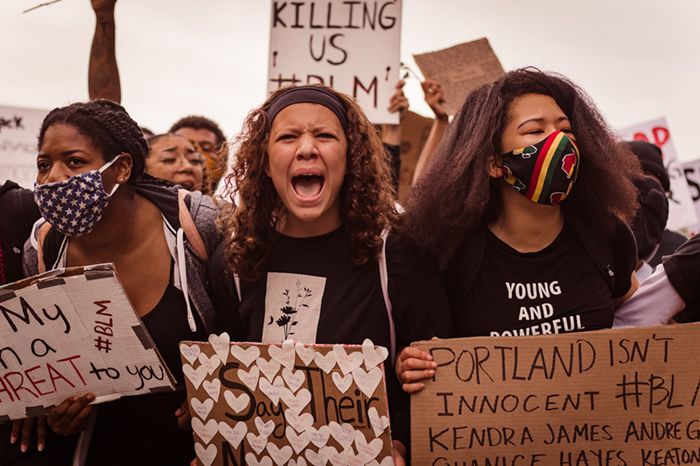Spring Is Coming
Prepare with the Mercury's Essential Guide to Arts and Culture
A Remarkable Journey Rewrites the Classical Music Canon
Portland Chamber Music's Anya Kalina on the Importance of African American Women Composers
Sallie Tisdale's Antidote to Clickbait
Violation Finds the Art in Artlessness
Walidah Imarisha’s North Star
Angels with Dirty Faces Takes on the Prison Industrial Complex
Vision Quest's Adult Funnies
Did You Know Portland Has a Free Comics Newspaper?
Samantha Wall Makes the Invisible Visible
The Contemporary Northwest Art Award Winner's Larger-Than-Life Drawings Explore Multiracial Identity
The Improbable Ascension of Noel Fielding
The Comedian of Mighty Boosh Renown Crosses the Pond
From Conduit to White Bird, Portland Dance Goes Back on Pointe
After a Year of Challenges, Portland Dance Companies Rally for Spring
The Narrow Door, Left Open
Paul Lisicky's Love Letter to a Friend
SAMANTHA WALL'S studio is an airy loft perched above busy NE MLK. The evening we met up, cars whizzed by below as we discussed photography, Korean culture, and childhood memories while looking at the quiet, poetic work on her studio wall—black-and-white drawings in various states of completion.
Wall creates larger-than-life portraits that stop you dead in your tracks. Drawings as big as seven feet by six feet, they're a collection of layered marks, an assembly of graphite, charcoal, and ink. Ranging from silhouette studies of women to larger pieces depicting Wall herself—in twisted and tense poses, with names like "Flayed" and "At the Threshold"—her work is masterful in skill and composition, in positive and negative space and the tension between the two.
As materially beautiful as Wall's pieces are, they begin with a photo and a conversation, which is as much a part of the work as the resultant drawings. They're part of a series called Let Your Eyes Adjust to the Dark, which grew out of a 2013 month-long artists' residency in New Orleans. There, she began to focus on photographing multiracial women and drawing from those photographs.
"During that month, I spent most of my time... having conversations with women who I ended up taking photos of," Wall says. "It allowed me to figure out how I can integrate photography more into my process. Part of that are the interpersonal relationships that I make with these women, the kind of residue it leaves, and how that affects the drawings. Building on top of that, this shared experience that we have."
Wall was born in South Korea in 1977, and moved to the States when she was around four, with her mother and stepfather (she has never met her biological father, who is most likely African American). "I have a memory of going to preschool, and not being allowed to participate in some kind of group activity, because I'm brown. All those pale little Korean kids—I didn't look like any of them. I have curly hair. It was like, 'Who are you? Why are you here?'" Wall says.
She later adds, "I was reading [a text] called Space Invaders about race, gender, and bodies out of place. In one section, the author is talking about being a person of color and being in places that are historically white spaces, being hyper-visible, but also invisible at the same time."
Wall's work is effective in making visible this invisible feeling. Even though her drawings are figurative and descriptive, they always retain that element of mystery. The profile of an individual is precisely defined, with a legible nose and stray strands of hair, which then give way to an abstract blossom of ink inside the body of the form. In a large drawing like "Flayed," which is a shadowy image of Wall, the middle of the body is so black, and at such a large scale, that up close it feels like a looming black hole.
The tradition of black-and-white drawings relates to a number of historical examples, in particular Wall's use of photography: its historical use in colonization, and in perpetuating stereotypes of race and exoticism. One of many examples of this—on display at the Portland Art Museum right now—is the "noble savage" imagery of Edward Curtis, who photographed Native Americans in the early 1900s. Wall's work can also be seen at PAM, where it currently appears as part of this year's Contemporary Northwest Art Awards exhibit. (As the recipient of the Arlene Schnitzer Prize, PAM awarded Wall a cash prize of $10,000; she also has work on display at the Laura Russo Gallery, as part of their show highlighting the work of awardees.)
Race is a crucial to Wall's work, but her drawings include aspects of something even more elemental. "In Roland Barthes' Camera Lucida, he talks about the 'air' of an individual, and how you come across certain images, like, whatever it is that makes that person distinct is really captured in that photograph. That's exactly the kind of images that I'm looking for," Wall says. These are the kind of images that are about understanding: understanding a person and experience, to whatever extent you can, and putting a face to the unknown.
2016 Contemporary Northwest Art Awards
w/Samantha Wall
Portland Art Museum, 1219 SW Park, through May 8, Tues-Sun, $19.99, portlandartmuseum.org
Dana Lynn Louis, Samantha Wall, and Akio Takamori
Laura Russo Gallery, 805 NW 21st, through Feb 27, free
More Spring Arts Articles:
A Remarkable Journey Rewrites the Classical Music Canon
Sallie Tisdale's Antidote to Clickbait
Samantha Wall Makes the Invisible Visible
The Improbable Ascension of Noel Fielding
From Conduit to White Bird, Portland Dance Goes Back on Pointe













